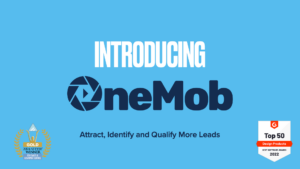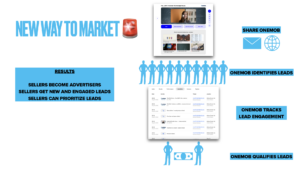Understanding Sales Velocity
One of the key indicators for sales growth and performance is Sales Velocity. Let’s dive into this subject and understand how tools like OneMob can tune up your sales process.
Defining Sales Velocity
Sales Velocity is a metric that indicates how quickly your organization is making money, a direct measure of how swiftly leads are turning into revenue. It’s a formula that considers the number of opportunities, average deal size, win rate, and the length of your sales cycle.
Significance of Measuring Sales Velocity
The beauty of Sales Velocity is that it pinpoints where you can improve your sales process. For instance, if your Sales Velocity is low, you might be spending too much time on opportunities that don’t convert or perhaps your deal sizes are too small.
Thereby, by increasing Sales Velocity, you accelerate your cash flow, which is crucial for businesses. Furthermore, the metric offers a fantastic way to evaluate the impact of sales and marketing efforts. After implementing a new sales strategy or marketing campaign, you can measure its success by looking at the change in your Sales Velocity.
Components of Sales Velocity
| Component | Description |
|---|---|
| Number of Opportunities | This refers to the number of potential deals your sales team currently has in your pipeline. An increase in the quantity of quality opportunities can escalate your Sales Velocity. |
| Average Deal Size | This is the average value of each deal in your pipeline. By increasing the average deal size, whether it’s by upselling or cross-selling, you can improve your Sales Velocity. |
| Win Rate | Your win rate refers to the percentage of opportunities that convert into a sale. A high win rate is an indicator of an efficient sales process, thus, enhancing your Sales Velocity. |
| Sales Cycle Length | This is the average amount of time it takes from the first contact with a potential customer to closing the deal. Smaller sales cycles lead to a faster Sales Velocity. |
Each component can significantly impact your Sales Velocity. Knowing how they work together and how to optimize each of them can prompt a significant increase in your organization’s revenue growth. In our OneMob platform, we provide tools and features to positively influence your Sales Velocity, from video messaging to boost engagement to optimize the email sending process, ensuring you make the most of every opportunity in your pipeline.
Sales Velocity is a critical component in any business’s strategic arsenal. But to truly leverage its power, we need a sales velocity calculator. This simple yet potent tool helps us understand, measure, and enhance how swiftly a prospect moves through the sales cycle. Before we delve deeper, let’s break down the formula of a sales velocity calculator.
The sales velocity calculator typically uses four major components: (1) the number of opportunities, or potential deals, (2) the average deal size, (3) the sales conversion rate, and (4) the length of the sales cycle. The formula is: (Number of Opportunities x Average Deal Size x Sales Conversion Rate) / Length of Sales Cycle. Quite straightforward, isn’t it?
Understanding the Impact of Each Component
Grasping the implications of each component can enhance your usage of a sales velocity calculator. The number of opportunities refers to the quantity of deals in your pipeline. Amplifying this can raise your sales velocity. Similarly, escalating the average deal size enhances revenue potential, thus increasing sales velocity. The conversion rate is equally vital – the higher your conversion percentage, the greater your sales velocity. Lastly, the sales cycle length inversely impacts sales velocity. The shorter your sales cycle, the faster your prospects convert to leads, thereby augmenting sales velocity.
A common mistake many sales representatives make is manually calculating these components. This not only leaves room for error but also consumes valuable time. This is where the real magic of a sales velocity calculator comes into play.
Benefits of Using a Sales Velocity Calculator
A sales velocity calculator presents numerous benefits. Firstly, it quantifies your sales process, offering a clear numerical overview of strengths and weaknesses. Furthermore, it allows for real-time tracking and monitoring of changes, empowering you to swiftly rectify any speed bumps in your pipeline. Imagine being able to identify and resolve a minor issue before it escalates into a major setback – that’s the power of a sales velocity calculator.
In essence, a sales velocity calculator fosters informative and predictive insights about your sales pipeline. With such powerful comprehension, you’re equipped to make significant adjustments for monumental improvements in your sales velocity.
Improving Your Sales Velocity
Following on from the magic that a Sales Velocity Calculator can bring to your sales strategy, let’s delve deeper into how you can improve your sales velocity. Remember the equation: Sales Velocity = (Number of Opportunities x Deal Value x Win Rate) / Sales Cycle Length. Each component of this formula matters, and improving even one can significantly impact your sales velocity. Let’s look at some strategies that can help you optimize each element.
Strategies to Improve Each Sales Velocity Component
- Number of Opportunities: Include measures like increasing marketing efforts to broaden your prospect pool, refining your target market, or enhancing lead qualification processes to focus on potential customers with a higher likelihood of conversion.
- Deal Value: One way to increase this number is by upselling and cross-selling. Tailor your approach based on the customer’s behavior, preferences, and needs. Additionally, consider focusing on selling to industries or businesses where the order size is typically larger.
- Win Rate: Building solid relationships with prospects, understanding customer needs, and providing value can improve your win rate. Consistent sales training can also ensure the team is equipped to close deals more effectively.
- Sales Cycle Length: Streamlining the sales process can reduce the sales cycle length. This could include removing unnecessary steps, improving sales tools, or providing additional training to sales reps.
Leveraging a Sales Velocity Calculator to Track Progress
As an experienced seller, one thing I’ve learned is the importance of tracking and adjusting. With a tool like OneMob, you can use its Sales Velocity Calculator to keep tabs on each component of your sales velocity. With real-time insights at your disposal, you can quickly identify areas where improvement is needed and adjust your strategies accordingly.
Case Studies of Successful Sales Velocity Improvements
In a recent case, a Silicon Valley tech company reported a 40% improvement in their sales velocity within six months of implementing OneMob. They witnessed an increase in their number of opportunities, win rate, and average deal value, while also reducing their sales cycle length. Another national retailer, upon using OneMob, improved their sales training program, resulting in a 30% increase in their win rate, significantly boosting their overall sales velocity.
In both cases, the Sales Velocity Calculator provided invaluable insights that made these improvements possible. Remember, data is power. The right information at the right time can be a game-changer for your sales.







